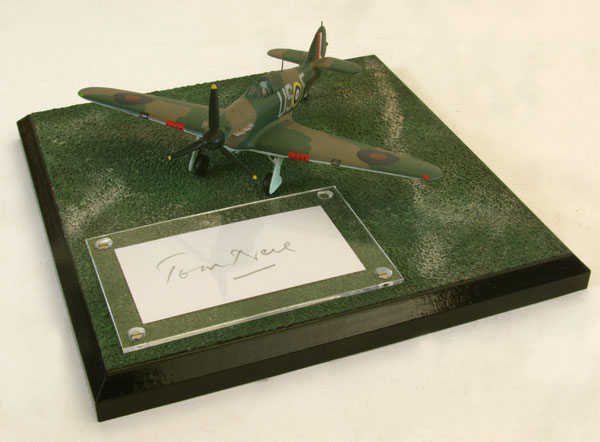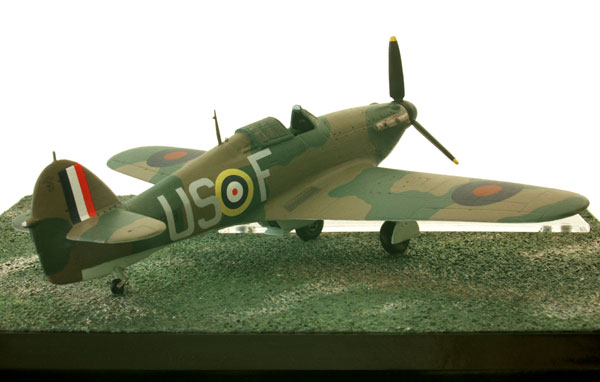Hawker Hurricane Mk I
Hawker Hurricane Mk I V7313 US-F
249 Squadron, Fg. Off Tom Neil, North Weald, September 1940.
The Hurricane Mk I was in many ways a bridge between the fighters of the early thirties and the more modern engineering and design techniques introduced with the partner with which it’s always associated, the Spitfire. Its origins were in the Fury Monoplane, a direct adaptation of Hawker’s elegant little biplane fighter, and its construction owed much to that also used by Hawker in the Hart series. This proved a significant advantage during the Battles of France and Britain when damaged Hurricane MK Is were able to absorb damage and be returned to operations relatively quickly, not least because the necessary techniques were well-known and practised; the relatively complicated Spitfire needed rather more work.
V7313 was from the fourth batch built by Hawkers at Kingston and Langley, deliveries of which started in July 1940, and was flown first by 56 Squadron from North Weald. With their Hurricane MK Is which bore the identifying codes US, they had been flying from North Weald since February, and were very active in the defence of London in the summer of 1940; by the end of August their losses were such that they were temporarily withdrawn to Boscombe Down, and 249 Squadron who came in from Boscombe to replace them took over the 56 Squadron aircraft. V7313 was one of those aircraft, still wearing 56’s marking when airborne on 1 September flown by Pilot Officer Tom “Ginger” Neil, who recorded being very upset when returning to base to find that the Luftwaffe had bombed his airfield. He subsequently flew V7313 several times before it was shot down, flown by another 249 pilot, on 12 October.
249 Squadron was formed at Leconfield in Yorkshire in April 1940, and was one of the RAF’s “gift” squadrons, the donor in this case being the Gold Coast, reflected in the bezant and elephant of the unit’s badge. Its first CO was Sqn.Ldr John Grandy who led the squadron until December 1940, being shot down and wounded on 6 September, and subsequently rose to be Chief of the Air Staff and a Marshal of the Royal Air Force, the only Battle of Britain squadron commander to achieve this rank. 249 were the highest-scoring squadron in the Battle of Britain, and in April 1941 were transferred to Malta with Hurricanes, flying off Ark Royal; these were replaced by Spitfires in the following year, and the squadron took part in the Italian campaign, finishing the war equipped with Mustangs.
THOMAS FRANCIS NEIL 71968
Neil was born in Bootle on July 14th 1920. He joined the RAFVR on October 17th 1938 and began his flying training at 17 E&RFTS, Barton, Manchester. Called up on September 2nd 1939, Neil went to 4I TW, Bexhill in early November.
On December 1st he was posted to 8 FTS, Montrose and on completion of the course, he was commissioned and joined 249 Squadron on May 15th 1940 at its reformation at Church Fenton.
Flying from North Weald on September 7th, Neil claimed a Messerschmitt Bf 109 destroyed, on the llth a Heinkel He 111, on the 15th two Messerschmitt Bf 109s and a Dornier Do 17 destroyed and another Dornier Do 17 shared, on the 18th a Heinkel He 111 damaged and on the 27th a Messerschmitt Bf 110 and a Junkers Ju 88 destroyed, a Messerschmitt Bf 110 probably destroyed and a Junkers Ju 88 shared.
On October 6th Neil shared a Dornier Do 17, on the 25th claimed a Messerschmitt Bf 109 destroyed, on the 27th a Dornier Do 17 probably destroyed, on the 28th a Junkers Ju 88 shared and on November 7th a Junkers Ju 87 ‘Stuka’ and two Messerschmitt Bf 109s destroyed. On this day Neil collided with Wing Commander F V Beamish during a patrol and lost his tail. He baled out of Hurricane V 7676, unhurt. Neil was awarded the DFC (8.10.40) and a Bar (26.11.40) and made a Flight Commander in December. In May 1941 249 Squadron went to Malta. The squadron flew off Ark Royal on the May 21st, Neil leading the second group of Hurricanes. After a series of mishaps and misadventures, they all reached Malta safely. On June 12th 1941 Neil destroyed a Mc 200. He left Malta on December 26th 1941 and returned to the UK, via the Middle East, South Africa, West Africa and Canada, finally arriving at Liverpool in early March 1942.
Neil was posted to 81 Group as Tactics Officer. He went to 56 OTU in mid-June and on September 1st 1942 he took command of 41 Squadron at Llanbedr. In July 1943 he was posted to 53 OTU, Kirton-on-Lindsey, as aninstructor. He later went to the 9th US Air Force, as Flying Liaison Officer with the 100th Fighter Wing. After D-Day Neil did some operational flying in France, as a supernumerary.
In January 1945 he was posted to the School of Land/Air Warfare at Old Sarum, instructing and lecturing. Neil went to Burma in March 1945, investigating. Whilst there, he flew some operational sorties with No 1 Indian Wing. He returned to Old Sarum in April, leaving there in January 1946 to go on an Empire Test Pilots’ course at Cranfield. He would go on to test and evaluate many of the captured Luftwaffe aicraft of World War II as well as become one of the few pilots ever to have flown the Martin Baker MB 5.
Neil was awarded the Bronze Star (US)(2.8.49) and the AFC (2.1.56). He retired from the RAF in 1964, as a Wing Commander.
PO 12.5.40 FO 3.3.41 FL 3.3.42 FL 1.9.45 SL 1.1.51 WC 1.1.57
Ref: Men of the Battle of Britain by Kenneth G. Wynn (CCB Publications)
Scale 1:72 Wingspan 6.67″ (169 mm)
Base size 7.71″ (196 mm) square (No. 5)
Weight not including base 9 ozs (252 grams)
Limited edition of 25 only
SOLD OUT




